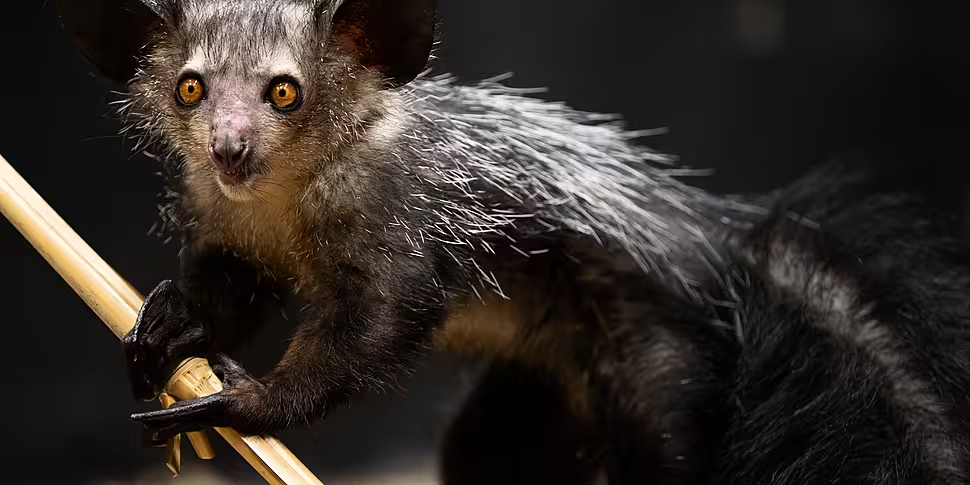Dublin Zoo has unveiled its newest habitat, a Nocturnal House which will be home to a brand new lemur species, the aye-aye, who are native to the island of Madagascar.
The Nocturnal House will be home to the Zoo’s aye-aye pair, male Peanut and female Tahiri, who arrived from Bristol Zoo last September, as well as their offspring.
A species of lemur, the aye-aye is the largest nocturnal primate and related to monkeys, apes and humans. They are visually striking animals, with dark brown or black fur and a bushy tail longer than their body. They have large eyes and ears, and slender fingers including a long middle finger that they use to tap on trees to listen for insects moving beneath the bark. Once they have chewed through the wood with their incredibly strong teeth, the same middle finger is used to fish for the insects. It is also used to scoop the flesh from fruits, which supplement the species’ insect diet.
To celebrate the arrival of this new species, on Saturday 29th and Sunday 30th July, Dublin Zoo will have plenty of educational and fun-filled activities for all ages from 12pm-4pm, including special keeper talks, crafts, games and face painting.
Aye-aye habitat
The new Nocturnal House at Dublin Zoo, which is located just beside Himalayan Hills and Sea Lion Cove, has been built specifically to meet the needs and unique ecology of this nocturnal species. The habitat mimics nighttime conditions allowing visitors to observe and learn about the nocturnal aye-aye's active nature. Visitors to the habitat will enter in complete darkness and will be guided by tiny lights on the ground to navigate safely and observe the animals.
At night, specialised lights and UV lamps will replicate daylight, encouraging the aye-ayes to sleep.
In the Wild
The aye-aye is listed as Endangered on the IUCN Red List. They have very large home ranges and are rare wherever they occur. Existential threats to the species include destruction of their natural habitat, and unsustainable levels of hunting. Some Madagascan people consider the aye-aye to be an omen of bad luck, and the animal has often been killed on sight, although there are laws in place that make this practise illegal.
Since 2014, Dublin Zoo has supported lemur conservation in Madagascar. Annual funding from Dublin Zoo is going to AEECL, the Lemur Conservation Association (www.aeecl.org), who work in and around the Sahamalaza – Iles Radama National Park in the northwest of the island to protect the aye-aye, the blue-eyed black lemur and other threatened lemur species that live in this area. Dr Christoph Schwitzer, Director of Dublin Zoo, is the Vice-Chair for Madagascar of the IUCN Primate Specialist Group, and as such is very closely involved with lemur conservation in Madagascar.
Project Funding
The investment of more than €400,000 to convert an existing building into the new nocturnal house for aye-ayes was partly funded by the Irish Government through the Office of Public Works (OPW).
Speaking about the new habitat, Dr Christoph Schwitzer, Director of Dublin Zoo, said,
“The launch of the new Nocturnal House, which will be home to our aye-ayes, is a wonderful moment for all of us here at Dublin Zoo. The aye-aye is a fascinating primate species, and every care has been taken to create a home for them here that takes inspiration from their natural environment in Madagascar.
This habitat is an important milestone in our “Dublin Zoo 200” plan, which aims to reposition Dublin Zoo as a zoo-based conservation organisation in time for our bicentennial celebrations in 2031. An objective of this strategy is to provide a holistic visitor attraction for all seasons, and this new Nocturnal House, the first ever such house at Dublin Zoo, is a big step towards this goal.
We are grateful to the Irish Government, and in particular to Minister of State Patrick O’Donovan, for helping us build this habitat with a capital grant through the Office of Public Works.”
The aye-aye habitat in the new Nocturnal House is open to the general public to visit from today. Book your visit online at www.dublinzoo.ie













